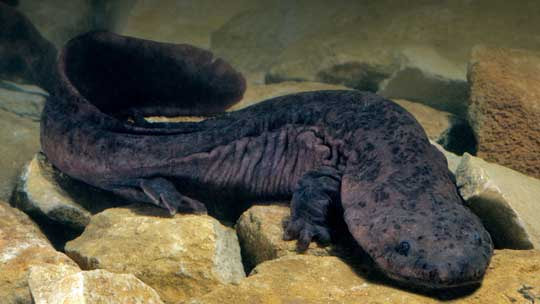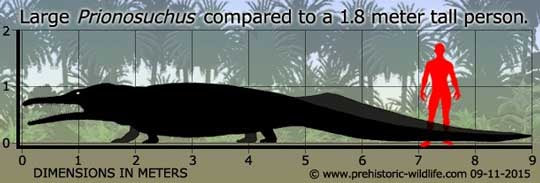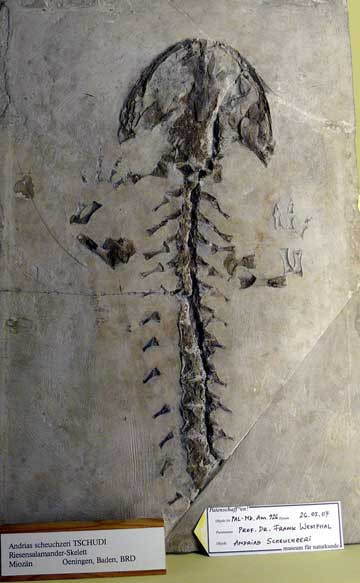|
I can't help it. I have to feature another amphibian (in my last post I featured the Caecilian). After all, Bridgers 6 is filled with awesome amphibians, so these critters are on my mind lately. Bridgers 6 takes place on an alternate version of Earth teeming with creatures descended from amphibians. There are big ones, small ones, scary ones, and tall ones! What's the biggest amphibian on our own version of Earth, you ask? Without a doubt, it's the Chinese giant salamander. What the heck is a Chinese giant salamander? Hiding in rocky streams in the Yangtze river basin of central China is an amazing salamander that grows to six feet (1.8 meters) long and weighs up to 110 pounds (50 kg). They are known to live at least sixty years, and possibly much longer. For a long time, scientists thought there was only one species, but genetic analysis indicates there are probably three or more distinct species. Giant salamanders belong to the family Cryptobranchidae. There is actually one other member of this family, the hellbender (also known as the snot otter), which grows to two feet long and lives in the eastern United States (I featured the hellbender back in May). Amazing facts about Chinese giant salamanders Giant salamanders are considered living fossils because the Cryptobranchidae family has been around for 170 million years. Much of their history was during the time of dinosaurs! They have changed very little during all that time. Giant salamanders spend their entire lives under water. Surprisingly, though, they do not have gills. Heck, they don't even have lungs. They get their oxygen by absorbing it directly through their skin. So, as you would expect, they need to live in streams with fast-moving, highly-oxygenated water. See all those folds of skin on the creature's sides? Those folds increase the surface area of the skin, which in turn increases the amount of oxygen absorbed. Giant salamanders are predators, and they eat almost anything that moves and will fit in their mouth. They will suck up aquatic insects, worms, frogs, other salamanders, freshwater crabs, shrimp, and fish. They even eat smaller individuals of their own species, In fact, one study found that 28% of all the food found in the bellies of 79 giant salamanders was other giant salamanders. Above I mentioned that they suck up their prey. This is called the gape-and-suck method, and it's actually a highly effective way to feed (many fish do this too). Here's how it works. When they sense prey in front of them, they greatly increase the size of their throat and pop open their mouth. This creates a powerful sucking action and draws in water, as well as any unfortunate creature swimming in the water. To make this even more effective, they displace their jaw in the process. This entire motion takes place in just a fraction of a second. Check out this slow-motion video of how powerful this prey-sucking methods works! I also mentioned above that giant salamanders "sense" the prey in front of them. They have very poor eyesight. Instead of seeing their prey, they have rows of special sensory nodes along each side of their body, from their head all the way to their tail. These sensory nodes allow them to detect the tiniest of vibrations in the water. So they "see" by detecting the vibrations other creatures create. This must work pretty well, because they catch enough prey to grow to over a hundred pounds! Sure, the Chinese giant salamander is a big amphibian, but is it the biggest amphibian ever? Not even close. About 275 million years ago, in the swamps and rivers of an area that is now Brazil, lived the Prionosuchus. Amazingly, Prionosuchus grew at least 30 feet long and weighed 4,400 pounds (2,000 kg). Prionosuchus was the amphibian version of a crocodile (does this sound familiar to those of you who have read Bridgers 6?), or more accurately, a gharial, a fish-eating crocodile with a long, narrow, toothy snout. The diagram below gives you an ideas of the size of the Prionosuchus. Keep in mind this creature was an amphibian! There is an interesting story behind the first identification of giant salamanders. Surprisingly, scientists knew about giant salamanders from fossils before discovering living specimens. In 1726, Johann Scheuchze described a fossil giant salamander from Switzerland. He mistakingly believed the fossil was of a human that had drowned in the biblical flood, the Deluge. So he gave the fossil the name Homo diluvii testis. In Latin, this means Man, a witness of the Deluge. The fossil (shown below) was about three feet (1 m) long, and the tail and hind legs were missing, so Scheuchze assumed it was a human child that had been violently trampled, perhaps in an attempt to escape the Deluge. In 1758, another scientist decided the fossil was a catfish. Then in 1787, another scientist decided it was a lizard. In 1809, yet another scientist concluded that it was "nothing but a salamander, or rather a proteus of gigantic dimensions and of an unknown species." Hmm... biology has come a long way in the last 250 years, hasn't it? Interestingly, in 1837, when the giant salamander was given its genus name (the name still used today), it was named Andrias. This means image of man. And scheuchzeri was assigned as the species name. These two names together honor Johann Scheuchze and his (mistaken) beliefs. By the way (I can't help mentioning this), the species Andrias scheuchzeri was used by the Czech author Karel Čapek in his 1931 science fiction novel, War with the Newts (also translated as War with the Salamanders). In the Pacific, a race of intelligent salamanders are found. They are enslaved and abused. But then they rebel, which leads to a global war for species domination. This satirical book is considered by many to be the first ever dystopian sci-fi novel, and many consider it to be the best science fiction book ever written. Chinese giant salamanders have inspired numerous myths and legends in Chinese culture. In fact, the commonly-seen yin and yang symbol is thought to have originally been two giant salamanders intertwined harmoniously. Also, these salamanders are often called wa wa yu, which means baby fish. Why? Because the giant salamander's distress call sounds like a human baby crying. Check out this brief video about the Chinese giant salamander. Okay, one more thing about the Chinese giant salamander. These creatures were once common in the rivers across southeast China. Unfortunately, now they are critically endangered in the wild. They have become a fashionable delicacy among the wealthy, and this has resulted in almost complete decimation in the wild from poaching. Today most giant salamanders are found on commercial farms that raise them for food, sometimes bringing $1,500 per salamander. The Chinese government encourages the farms to release some of their salamanders into the wild. At first, this seems like a good idea. BUT... scientists have found that the farm-raised salamanders are genetically different from those in the wild. It seems the wild salamanders can easily be divided into five very different genetic groups, and the groups split apart from each other millions of years ago. But the farm salamanders are a result of extensive genetic mixing. So, the original genetically-distinct types in the wild are quickly being replaced by these new, artificially-mixed salamanders that never existed before. Hmm... an interesting dilemma. So, the Chinese Giant Salamander deserves a place in the B.A.H.O.F. (Boffo Animal Hall of Fame). FUN FACT: The word boffo was first recorded in use in the 1940s. Basically it means sensational or extremely successful. By the 1960s, the word was commonly used in show business. This usage is thought to have originated in the Hollywood trade magazine Variety. Example: "It was a boffo performance, impressing even the harshest critics." So, basically, boffo means it's a hit. In spite of the giant salamander's recent troubles (being endangered), the fact that the creature has been around for 170 million years indicates a boffo performance (evolutionarily speaking). So, boffo is another way to say awesome! Photo Credits:
Indian pipe - Stan C. Smith Man holding giant salamander - Pinterest Giant salamander in river - San Diego Zoo Girl with salamander in zoo - Getty Images via DailyMail Giant salamander fossil - Wikimedia
1 Comment
Brian Gibbens
3/24/2024 08:51:11 am
Quick Question. I am curious about the photo of a man holding a giant salamander. Where/when was this taken. What is the proper photo credit (i.e. who was the photographer)?
Reply
Leave a Reply. |
Stan's Cogitations
Everyone needs a creative outlet. That's why I write. Archives
July 2024
|







 RSS Feed
RSS Feed